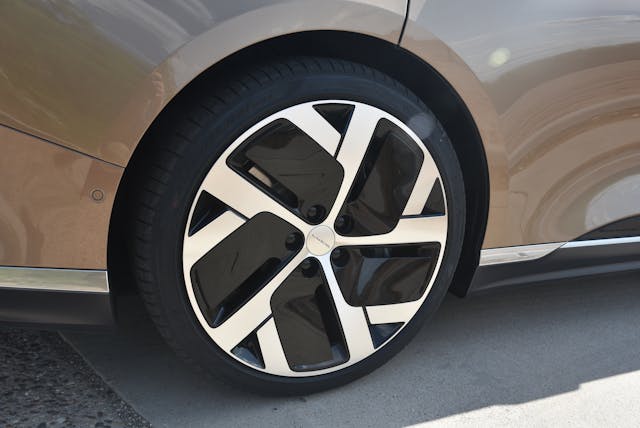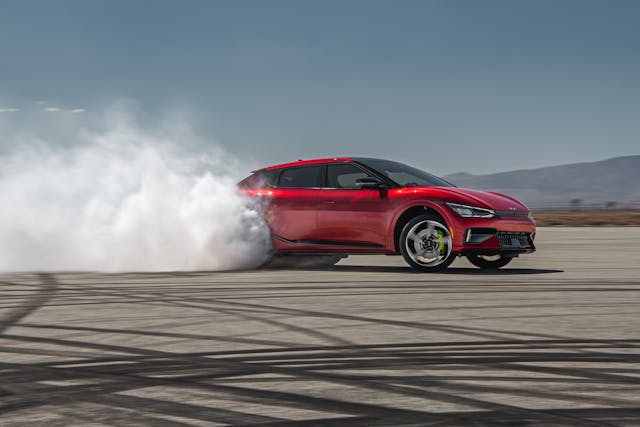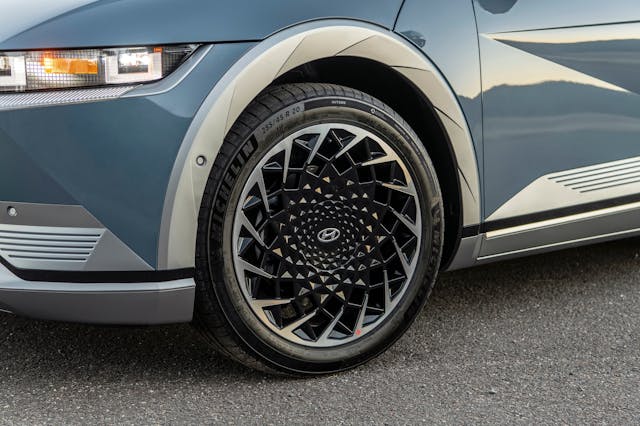Why EVs need special tires

Of all the things that appear universal in the car world, tires top the list. They are rubber, round, and more often than not have tread on their outside surface. They may vary according to weight capacity and seasonal appropriateness, but, in the grand scheme a tire is a tire, right?
Wrong.
We wish tires were that simple, too, but they’re just not. The latest reminder of their complexities comes from Jason Fenske and his YouTube channel Engineering Explained. Fenske dives into how tires produced for electric vehicles (EVs) differ from the tires that get mounted to internal-combustion-powered cars.
Yes, it sounds a little absurd, but with more information, you’ll see why EVs need tailor-made shoes.
Vehicle weight

The first factor is vehicle weight. The carcass and material of an EV-specific tire are markedly different than those of a “regular” tire. Comparing the two will show that the EV tire has a stiffer sidewall to help control the extra heft of the vehicle to which it is attached.
It may seem that additional stiffness serves to maintain the proper contact patch (the portion of the tire that is touching the road) while rolling forward, thus preventing the tire from collapsing onto the pavement. That’s true, but a sidewall is just as vital to controlling the deformation of a tire under direction changes.

When you turn a vehicle’s front wheels, you’re asking the tire to hold its shape while weight of the car fights to keep the vehicle—and thus, the wheel and tire—traveling straight. (Mean ol’ Mr. Momentum. —Ed.) That contact patch is under high stress during direction changes, which may be why most EV tires have a larger one. The increased surface area distributes the load across more of the tire. A bigger contact patch also keep tire temperatures in check, because the road acts as a heat sink, and more contact with the ground pulls more heat out of the tire carcass.
Aerodynamic efficiency

The second differentiating factor is aerodynamic efficiency. This concern isn’t unique to makers of EV-specific tires, but minimizing rolling resistance is extra important when designing a tire for an electric vehicle because the EV market is hyper-focused on maximizing driving distance per charge. Generally, that means a narrower tire is better.
Fenske does the math to show that tire selection can increase or decrease range by 30 miles per charge fairly easily, and that’s before you factor in driving style or conditions. Pennies make dollars.
Noise

This is a very interesting one, because cars have been getting quieter for decades. However, when you remove the noise of the internal combustion engine and ancillary drivetrain components, suddenly tire noise is one of the loudest things your ears pick up.
To fight this, many manufacturers will use a polyurethane foam liner inside the tire that helps prevent resonance in the carcass. There is also a pattern molded into the tread which does the same thing. Combined, the liner and the tread pattern can lower tire noise to a level at which you’ll barely notice it when inside the car. Really, though, minimizing tire noise leaves you with wind noise, which is not nearly as easily solved.
Grip

The last is grip. Funny that it’s the final factor mentioned, since grip is likely the first thing that comes to your mind when tires are brought up in conversation. EVs make crazy torque numbers, and therefore may encounter traction issues at speeds at which an ICE-powered car usually wouldn’t. Creating a tire that has enough traction to translate the immediate punch of an electric motor into motion is tough, especially when you’re also trying to make the tire strong, skinny, and quiet.
Hopefully now you better understand why electric vehicles get their own tires, just like semi trucks, trailers, and passenger cars. As the automotive market has continued to expand and grow ever more specialized at the same time, it only makes sense that the industry also produces tires to fit more and more specific situations.
Getting a look inside these EV tires helps us understand just how interconnected all the parts of a car are—and what could happen when those of us without engineering degrees go about “improving” our cars.

Check out the Hagerty Media homepage so you don’t miss a single story, or better yet, bookmark it.


Paint that Hyundai rim in the final photo of the article gold and it would be a match for the holiday serving tray to dish out the olives…
This is nothing odd. To be honest most tires are getting more and more model specific. Just look at the number of tire models we have and how many were designed specifically for some models.
HV mostly need the rolling efficiency as the automakers demand it and tire companies have made great strides.
As for Weight that is a factor even on ICE as some SUV models are very heavy today.
Aero ehh they do what they can with some models but like Hummer not so much as it needs the larger tires.
The auto mfgs are demanding quiet as these cars pick up all sorts of road noise and the want it quiet.
Goodyear and others have been making special tires since the Volt and Prius arrived. They will pay extra to put better tires on vs the cheap crappy Hankooks just to get the car out the factory door.
Weight has been a factor in prior decades though low profiles are new — take for example my 1973 Cadillac front wheel drive Eldorado with 8.2 litres and transaxle over the front tires and a curb weight exceeding 5,000 pounds — it rides on 75 series tires on 15 inch rims. Soft ride over performance is it’s biasing.
Interesting article. Do tires for EVs cost more than ICE tires?
Sidewall stiffness doesn’t play much part in steering response. The stiffnes of the tread area, viewed in plan view, is much more important. Typically, replacing run-flat tires, which have very stiff sidewalls, with good performance tires with soft, flexible sidewalls, improves steering response. I’ve expeerienced this personally wth BMW and Audi carrrrrs, and tire design books will substantiate.
Heavy vehicles need tires with stiff sidewalls to reduce flexing and te consequent heat build up.
Physical limitations, as well as cost, limit the size of the tires that can be fitted to most cars. Larger tires can improve almost all apects of handling, whether the caris electric or ICE.
So there’s a good chance the smug “I spent zero dollars on gas for my BEV” might be followed by a sheepish “and thank God because I spent $2K a year on special BEV tires!” in the near future…
Not surprising at all. Tire manufacturers have been custom designing various tire models to accomodate or enhance certain quailities for decades. The unique demands of electric cars come as no surprise.
I read an article elsewhere that noted that the extra weight of EVs causes their tires to wear faster. This, in turn, leads to increased “rubber pollution” of the environment. This, coupled with many other factors, is one more indicator that EVs aren’t so “green” after all.
It’s a fortunate thing that all EV braking is by battery-replenishing backcharges, or otherwise they’d use up a lot of braking material too — a prime contributor of the Engines of Death phenomenon. Lugging a half-ton of extra virtue around with you is going to be expensive!
I see big, heavy, expensive tires in your future.
I find it humorous that EV’s need tires with extra grip, because “EV’s make crazy torque numbers”. I know that electric motors are capable of making a lot of torque and EV manufactures market their cars with gimmicks like “insane mode”. But if EV makers and buyers really cared about the environment, their cars would limit the amount of current delivered to the motor in order to extend the range. The need for high grip tires suggests that EV’s are toys rather than ways of saving the planet.
Right you are Jay. They are toys. I see Prius’s and Teslas fly by me all the time. Better mileage my foot.
Just one quibble/correction to this article: EV tires would not inherently have a “larger Contact patch” as stated. Contact patch area is solely a function of load and inflation. The shape of tha patch may change; e.g., a wide, low-profile tire will have a wider, but shorter patch for increased lateral grip. A narrow, high-profile tire will have a longer, narrower patch. In either case, however, given equal load capacity and inflation, the actual area of the patch would be the same
Dave, your logic is not correct. A wider tire provides a wider patch but does not change the length of the patch. If your logic was correct we would not put wider tires on high horsepower vehicles.
Maybe you should re-read my comment. That’s exactly what I said. A wider patch helps cornering in particular and may also help starting traction, depending on rubber compound. But the total area of the patch in square inches is altered only by weight and tire pressure. That’s why specialized drag tires are designed to operate at very low air pressures. Lowering the pressure does increase the total area of the patch (within limits).
Actually. sidewall stiffness is a major determinant of contact patch. Think wagon wheel vs a balloon tire as the extremes. A stiff sidewall supports weight in addition to tire inflation.
I see some of the envious of EV types are commenting. They always try and deflect blame from themselves for polluting. Most of them have never driven an EV and have no idea how much better they are.
Maybe some people just don’t consider child slavery to be acceptable the way EV proponents do.
I don’t know where my cobalt and lithium comes from but I do know that I get tired of being blamed for what other people might do on the other side of the world. You might know where your gas comes from but where does it go? Yeah you do know. Take a whiff of your tailpipe.
https://www.foxnews.com/media/joe-rogan-podcast-guest-explains-heart-wrenching-source-electric-vehicle-iphone-batteries-viral-video
I’d never before considered asphalt as a heat sink but now that I am I think it could go either way depending on the season and climate.
You take the engine, transmission, exhaust system, radiator and related plumbing as well as gas tank out of an ICE vehicle and replace it with a battery and maybe 1- 2-3 electric motors, why do we need special tires for a BEV when the weight is probably equal, sounds like a cash grab.
You take the engine, transmission, exhaust system, radiator and related plumbing as well as gas tank out of an ICE vehicle and replace it with a battery and maybe 1- 2-3 electric motors, why do we need special tires for a BEV when the weight is probably equal, are special tires a sleazy cash grab?–